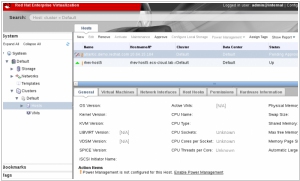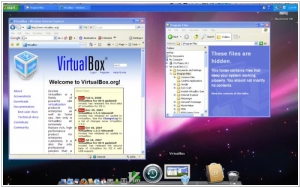Red Hat Virtualization vs VirtualBox
July 25, 2023 | Author: Michael Stromann
7

Red Hat Virtualization is an open, software-defined platform that virtualizes Linux and Microsoft Windows workloads. Built on Red Hat Enterprise Linux and the Kernel-based Virtual Machine (KVM), it features management tools that virtualize resources, processes, and applications—giving you a stable foundation for a cloud-native and containerized future.
7

Oracle VirtualBox is a powerful virtualization product for enterprise as well as home use. Not only is VirtualBox an extremely feature rich, high performance product for enterprise customers, it is also the only professional solution that is freely available as Open Source Software under the terms of the GNU General Public License (GPL) version 2. See "About VirtualBox" for an introduction.
Red Hat Virtualization (RHV) and VirtualBox are both popular virtualization solutions, but they have significant differences in their target audience, features, and support models. Red Hat Virtualization is an enterprise-grade virtualization platform built on KVM (Kernel-based Virtual Machine) and is designed for businesses seeking a robust, scalable, and cost-effective virtualization solution for Linux-based environments. RHV offers advanced features like live migration, high availability, and centralized management through the Red Hat Virtualization Manager. It is well-suited for organizations that prioritize open-source technologies and seamless integration within the Red Hat ecosystem. RHV provides enterprise-level support through Red Hat subscriptions, ensuring timely updates, security patches, and expert technical support.
VirtualBox, on the other hand, is an open-source virtualization software developed by Oracle. It targets a broader audience, including home users, developers, and small businesses. VirtualBox offers a user-friendly interface, making it easy to set up and manage virtual machines on various host operating systems, including Windows, macOS, Linux, and more. It provides a range of features like snapshots, drag-and-drop functionality, and support for a variety of guest operating systems. VirtualBox is a great choice for individuals and developers looking for a free and versatile virtualization solution.
Another key difference between RHV and VirtualBox lies in their virtualization approach. Red Hat Virtualization is a Type 1 hypervisor, meaning it runs directly on the physical hardware, providing better performance and efficiency for production workloads. In contrast, VirtualBox is a Type 2 hypervisor, running on top of an existing operating system, which may result in slightly reduced performance compared to Type 1 hypervisors.
See also: Top 10 Virtualization platforms
VirtualBox, on the other hand, is an open-source virtualization software developed by Oracle. It targets a broader audience, including home users, developers, and small businesses. VirtualBox offers a user-friendly interface, making it easy to set up and manage virtual machines on various host operating systems, including Windows, macOS, Linux, and more. It provides a range of features like snapshots, drag-and-drop functionality, and support for a variety of guest operating systems. VirtualBox is a great choice for individuals and developers looking for a free and versatile virtualization solution.
Another key difference between RHV and VirtualBox lies in their virtualization approach. Red Hat Virtualization is a Type 1 hypervisor, meaning it runs directly on the physical hardware, providing better performance and efficiency for production workloads. In contrast, VirtualBox is a Type 2 hypervisor, running on top of an existing operating system, which may result in slightly reduced performance compared to Type 1 hypervisors.
See also: Top 10 Virtualization platforms



